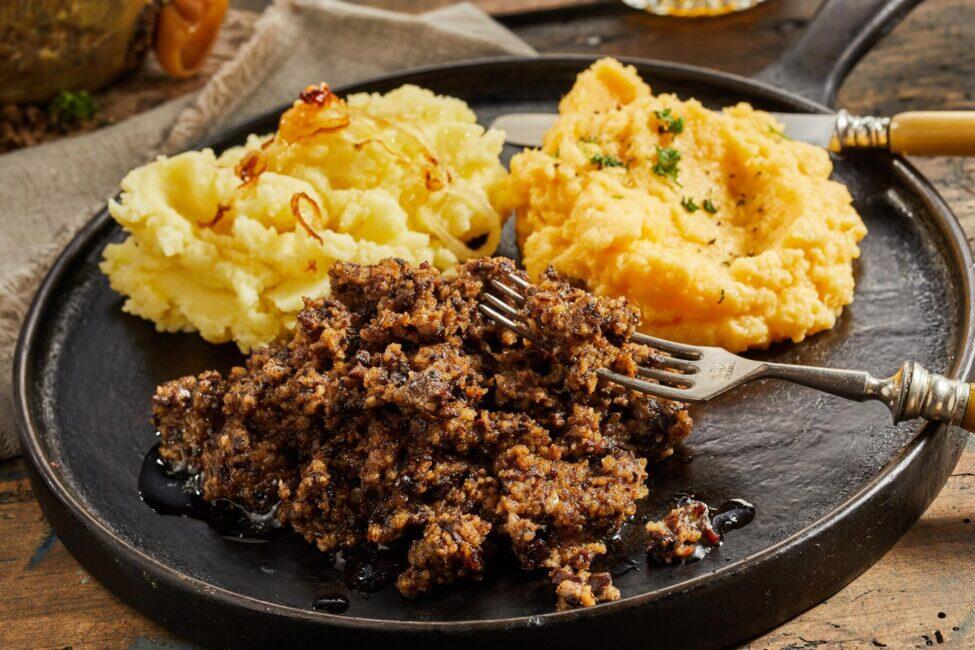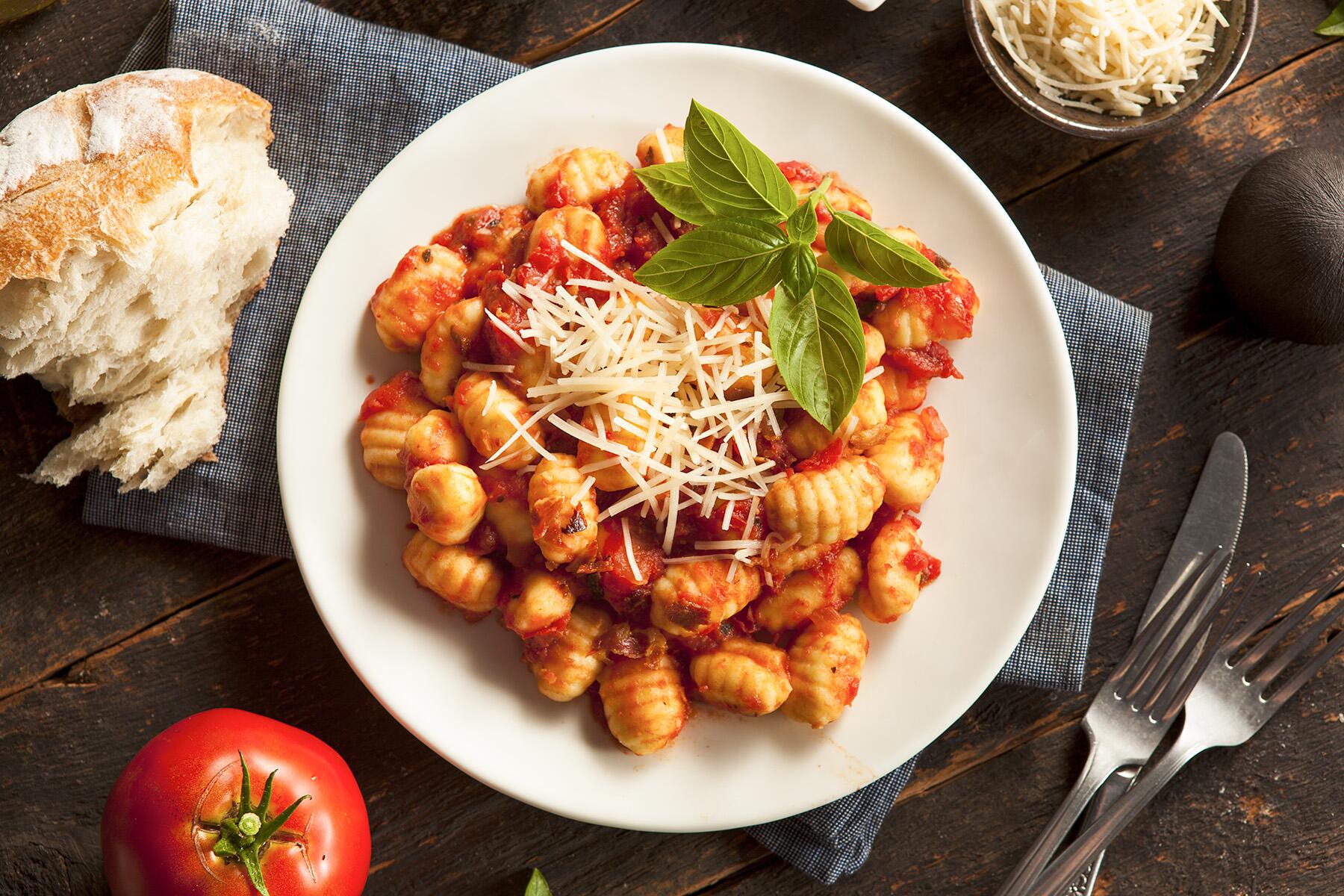And it has to do with haggis, the national dish of Scotland.
I’m afraid we’re going to have to get into a sticky subject straight away: Haggis isn’t really Scottish. There. The shockingly unsayable has been said.
Well, actually, let me qualify that. It is Scottish, in that it sits at the very heart of our national identity. It’s just that its origins may not be as Scottish as first thought. Alongside deep-fried Mars bars (a joke started by two tipsy chip shop customers in 1995) and clan tartan (made popular by two Welsh brothers, as we shall discover later), some definitive Scottish artifacts are not quite what they appear.
First things first though—what exactly is haggis? It’s probably best not to go too far into the detail, but we will say that the traditional recipes feature sheep’s pluck—the heart, liver, and lungs—mixed with oatmeal, suet, and spices, and cooked in the sheep’s stomach. While it might not sound it, haggis is very tasty. Tradition has it that the majestic haggis is served with neeps (turnips) and tatties (mashed potatoes), most often with a great ceremony on Burns Night.
The origins of haggis are somewhat shrouded in Scotch mist, with some claiming it goes as far back as Homer. Others say the Vikings introduced it. The first known printed recipe is held in the British Library, featured in the English Booke of Curtassye in around 1430.
Recommended Fodor’s Video
Whatever the truth, it is most likely that some version of this peasant’s dish existed in Scotland just as it did in other countries, as it was inexpensive, easily transportable, and made use of animal parts that would otherwise go to waste.
The question is, how did haggis become inextricably linked with Scotland?
A Turbulent Period in Scotland’s History
In 1707, Scotland signed the Act of Union with England, leading to the creation of the United Kingdom. The two countries, despite now being united, remained very different. The Scottish highlands were still ruled by fearsome Celtic clans that, in the manner of Braveheart, would never let anyone take their freedom. Completely ungovernable, the clans and chieftains of northern Scotland had their own system of society and little intention of giving it up.
But change was coming. The undoing of the ancient clan system, an extricable part of Scottish identity, began with the Jacobite uprising of 1745—an attempt by Bonnie Prince Charlie to regain the British throne. After Scottish forces invaded England as far south as Derby, the Jacobite campaign ended in carnage on the battlefield at Culloden, wiped out by the Duke of Cumberland’s army. Soon afterward the wearing of tartan and “highland dress” was outlawed, along with the right to bear arms.

The uprising left a bitter taste in many mouths. English folk were profoundly resentful of the invasion and attempt at their crown. Polite society poked fun at the “heathens of the north,” attacks in the press depicting Scots as poverty-stricken barbarians with few clothes to wear and even less to eat. The Scottish diet was ridiculed as spartan and unedifying, unlike that of the well-fed Englishman. As diarist Samuel Johnson wrote in 1755, oats were “a grain, which in England is generally given to horses, but in Scotland supports the people.”
There was truth in this depiction. In Scotland, the notorious highland clearances were now putting the final nail in the coffin of the clan system—violently displacing people from their land and causing widespread hunger and poverty. The image of the poor Scot eating plain rustic food was not far from reality. Haggis was coming home.
Along Comes Rabbie Burns
Against this volatile backdrop, a young man was growing up in rural Ayrshire in southwest Scotland. His name was Robert Burns, and he would shortly become both Scotland’s foremost poet and the man who helped seal haggis in the national consciousness. Riled by the sniping, in 1786 Burns penned To A Haggis as a somewhat savage riposte to the way Scots were portrayed.
In the poem, Burns did what Scots are great at, making themselves part of the joke. Yes, we ate haggis. And yes, we were damn proud of it. After humorously introducing the beast with “hurdles [buttocks] like a distant hill,” Burns’ tone darkens as he warns:
But mark the rustic, haggis-fed,
The trembling earth resounds his tread,
Clap in his ample fist a blade,
He’ll make it whistle;
And legs, and arms, and heads will cut off
Like the heads of thistles.
King George IV Visits Edinburgh
A further literary twist on haggis’ fortunes comes when it is championed by Sir Walter Scott, another great name in Scottish literature. As portrayed in his novels Rob Roy and Waverley, Sir Walter loved a romantic historical vision of Scotland, full of misty-eyed views of glorious highland mountains and heather-strewn moors.
Scott’s friendship with King George IV persuaded the King to make the first visit of a reigning monarch to Scotland in 171 years. The writer was eager to present the Scotland of his novels, and the King, a great fan, was just as eager to become a real-life Monarch of the Glen. Scott carefully choreographed every detail of the visit to showcase his idealized version of Scotland, from decreeing that ladies at court must have at least nine feathers in their head-dress to ensuring that haggis take center stage at the banquet in the King’s honor.

King George, who was rather portly and fond of frippery, turned up in full highland regalia. His kilt was reported to be far too short, ending well above the knee, so rather than run the risk of people laughing at his bare flesh, he wore a pair of pink tights instead. Which, of course, didn’t look amusing at all.
It all went toward producing a vision of Scotland that has stuck to this day, that of tartan, haggis, and shortbread.
The Wild Haggis of Rannoch Moor
The enduring idea of haggis today remains slightly hazy in many a mind. What exactly is it? Is it legal? Is it alive? The latter is probably complicated by a running joke instigated by most of Scotland, which is to maintain that the haggis is a wild beast with an annual hunting season.
One of the world’s foremost art galleries and museums, Glasgow’s Kelvingrove, features an exhibit of a taxidermy wild haggis, Haggis Scoticus, next to a supermarket version. A quick Google search returns numerous websites telling the story of the wild haggis, rabid beasties that have short legs on one side of their body so they can run around the steep highland hills without falling off.
None of this is true, although it could explain why about 5,400 U.S. citizens search Google every month to find out if haggis is an animal. It probably can’t explain the 140 who searched for “pet haggis,” though—as if a wild haggis could ever be domesticated!
And so, the legend of haggis lives on, woven into the fabric of Scotland’s story. It may not be the one you expected, but you’ve got to admit, it’s a good story nonetheless.
All that talk about haggis and no recipe included. How's displaced Scottish descendent in America ever going to survive?





This article is a perfect portrayal of American ignorance and stupidity. Imagine thinking Haggis is an animal. Just how foolish can one be?